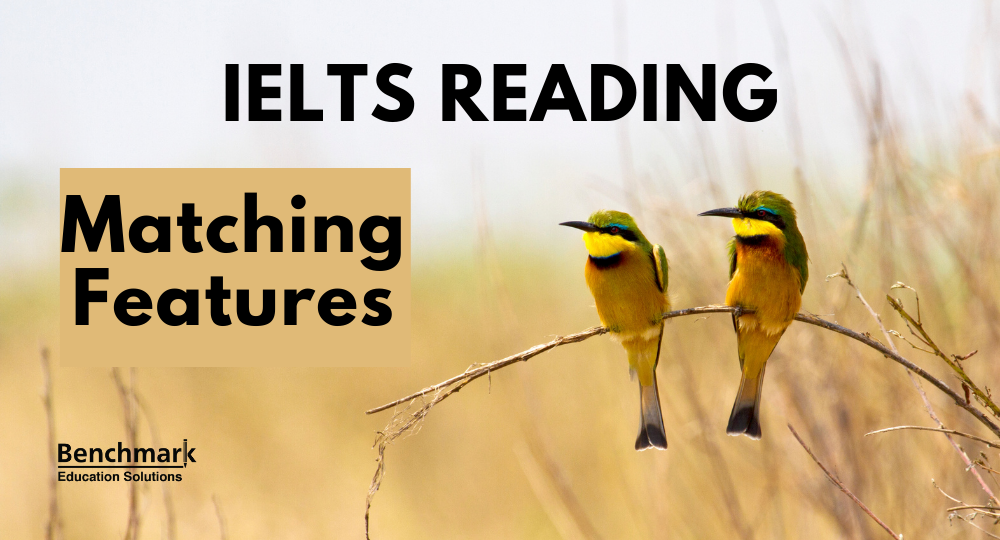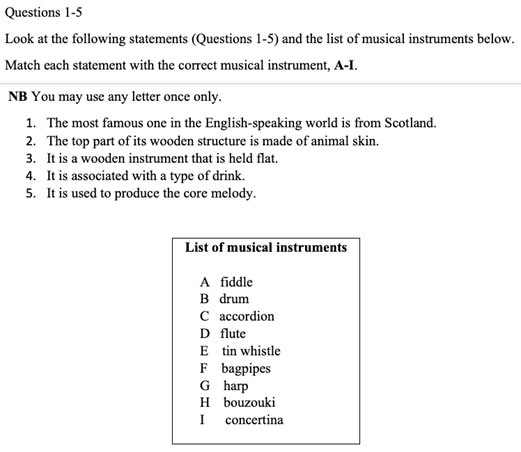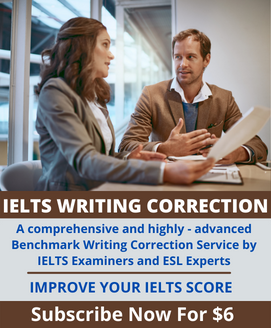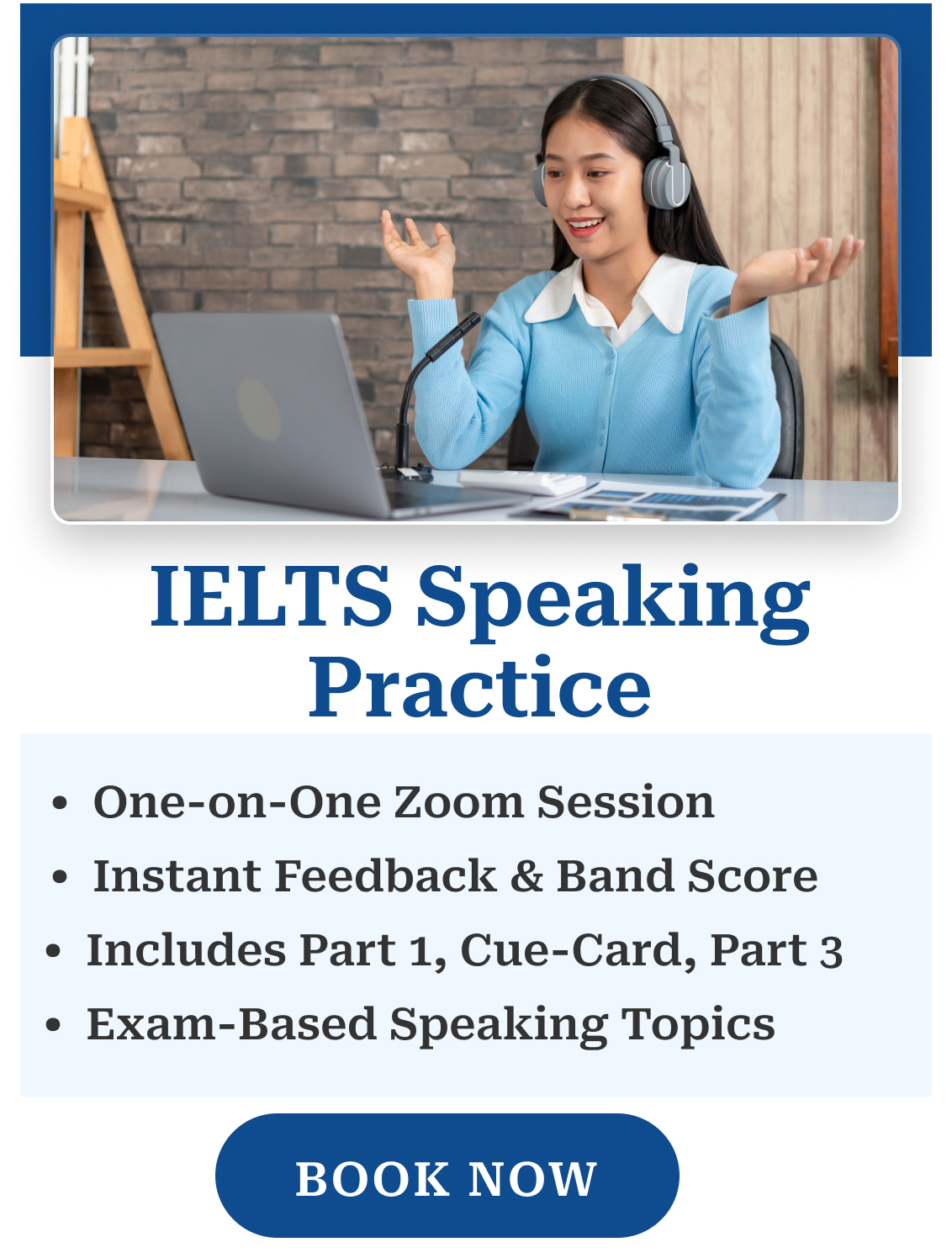

IELTS reading feature questions involving matching statement type may cause confusion to some candidates, as the answers do not come in order. This therefore requires IELTS test takers to use both their reading skimming and scanning skills, which may seem overwhelming to some.
Worry not, Benchmark IELTS has helpful tips and tricks, as well as example questions to help you!
Table of Contents
1. Question Overview
The Feature Question type is one of fourteen (14) question types on the Reading Section of the IELTS exam.
- Objective: You must identify the information in the questions within the text, then match that information with the appropriate category in a given list.
- Skills Used: You will need to skim and scan the text for specific information and choose the category that matches the information, from a list of options.
The questions will be statements – in other words, sentences that will contain information to look for in the text. You will also be provided a list of categories, and each category will be preceded by a letter. You will need to use those letters as your answers. The statements will contain key words and/or phrases you will need to paraphrase, and which will help you locate the information in the text.
If you feel you may need support and practice in completing this task, continue reading for tips and practice!
Check out our article with an overview of all the Reading question types on the IELTS exam!
2. Example of Features Matching Question
This is how the Features Matching Question will appear on your IELTS reading question paper


3. Steps to Follow
How should you answer questions that require you to match statements from the list? Follow our steps below!
3.1. Read the Instructions Carefully.
The instructions in this task will tell you how many times you may use the categories in the list. The instructions could say you may use each category once only, or they may indicate that you may use categories more than once. Bear in mind, not all categories will necessarily be used as answers!
3.2. Read and Understand the Statements, and Familiarise Yourself with the List
Because you are looking for specific information in the text, it essential that you read the statements carefully and understand what they mean. Ask yourself what is the key information you are required to find? For instance, if the statement says ‘it contains the least number of calories’, you will then likely need to look for information about a food item. Once you have done that, you may look at the list and read through the categories. Make sure you know what they are about (a list of countries, names, food items…). You will need to know what the categories are in order to be able to match the information in the statement with the appropriate category.
3.3. Paraphrase the Features Questions
Paraphrasing the questions means saying what they mean in different words, focusing particularly on key words/phrases:
Example:
‘it is mostly imported from Mexico but is also grown in eastern and western coastal areas of the United States
In other words: ‘It mostly comes from Mexico, but it is also cultivated in the East and West coasts of the USA.’
If you explain the questions in other words, you make sure you understand them better, and you can see more easily where the meaning is expressed in the text.
3.4. Skim the Text
To skim the text means to read it quickly to get the general idea. This is a good way to familiarise yourself with the content, since you will need to find specific information in the text. Reading the text quickly should help you notice certain words that might be helpful when looking for answers in the text. This will also give you a broad idea about the nature of information in each paragraph, thereby helping locate the rest of the information, as well.
3.5. Scan the Text for Information
To scan a text means to read it quickly while looking for specific information. You don’t need to read or understand every single word, as long as you are able to identify specific information that helps you answer the question, including synonyms to key words you have paraphrased.
3.6. Choose the Correct Answer
After you made sure you understood the question, and you have skimmed and scanned the text for specific information, you can choose the category that matches the information.
4. Tips & Tricks
3.1 You must read the instructions carefully. They will tell you the type of categories in the list and how many times you are allowed to use each category.
3.2 Not all categories may be used. Some categories may be mentioned in the text, but not used as answers to the questions.
3.3 Read all the questions before reading the text. Because the answers do not come in order, you want to make sure you know what specific information you are expected to look for in the text before answering the questions. This will help you make the most of your time.
3.3 When paraphrasing the questions, think of synonyms to key words and/or phrases in the questions:
Example: ‘Flipflops used by the Ancient Greeks were most similar to those u>employed by people today.’
used by the Ancient Greeks = worn by/common amongst/employed by the Ancient Greeks
most similar to = looked most like /resembled most/ were most alike
employed by = used by/worn by
today = nowadays, modern, current/currently
3.4 The advantage of skimming the text is that scanning becomes easier, as you are familiar with the content. because the answers will not come in order, so you may need to go back and forth in the text. Skimming the text will help reduce the time you spend scanning the text for information.
3.5 The answers will not come in order, so you may need to go back and forth in the text. Skimming the text will help reduce the time you spend scanning the text for information.
3.6 You may even attempt this question type after you have answer rest of the questions in the passage. This should give you sufficient insight into the passage and you’ll be able to find relevant location with ease.
5. Mock Test
Instruments of Celtic Music
Celtic music originated in Western Europe. It has existed for centuries, and is often associated with Ireland, Scotland, Wales and the French region of Brittany. Celtic music has influenced a range of musical styles, including American Bluegrass and country music. For many, Celtic music has the quality to bring out deep emotions and feelings. When thinking of Celtic music, often the first instrument to jump to mind are the bagpipes. Although such instrument has been played in a range of European countries, perhaps the best-known kind of bagpipes in the Anglophone world are the Scottish Great Highland bagpipes. The bags are called bladders and are made of leather. Musicians press the bottom of those bags under their arms, and make a tune using the chanter, which looks like a recorder.
There are, however, so many more instruments that help compose such touching melodies. One of those instruments is the Celtic harp. Not only is it the logo of the famous Irish Guiness Stout beer, it is also the symbol of Ireland. For thousands of years, the Celtic harp was used to not only provide musical entertainment, but also as a means to tell stories. Modern Celtic harps are 4 feet high, and contain thirty-four strings.
Another string instrument used in Celtic music is a more recent creation invented in the 1960s. It resembles a mandolin or a banjo, although it produces lighter sounds. It is called the Irish bouzouki, and it is a variation of the traditional Greek bouzouki. While the latter is flat at the front and rounded at the back, the Irish bouzouki is flat on both sides. There is a long neck attached to it used by musicians to produce the sounds through picking or strumming with their fingers.
Perhaps one of the most famous instruments is the fiddle. It looks like a violin, but its strings are made with steel rather than gut or nylon. It produces very soulful, haunting sounds, and inviting danceable tunes. While the violin creates long-lasting, extended sounds, the fiddle makes sharper and shorter outbursts. The fiddle is played differently depending on the region.
Some woodwind instruments are popular in Celtic music, too. One in particular is the easiest to carry and has been a core instrument of Celtic music for a long time – the tin whistle, also known as the penny whistle. It is closely related to the flute and is made of metal. Musicians use their fingers to play with the six stops available to them. It is a very useful instrument for creating the main melody in a song. Supporting this main melody is the use of the flute. Traditional ones are made of wood and, contrary to the tin whistle, it is held horizontally.
Another very important element to Celtic music is the use of percussion. The Bodhrán (pronounced bow-ran) is a type of circular drum with a wooden frame and goatskin stretched over it. It can provide a range of sounds using a drumstick named a ‘beater’, although musicians may also use their hands. The closer musicians get to the centre of Bodhran, the deeper sound will be. For shorter sounds, one should use the sides of the drum.
There are some keyboard instruments that make an important core part of traditional Celtic folk music. These are the accordion and the concertina. There are different types of accordions, but the one used in Celtic music is a two-row button accordion. To play the accordion, musicians move the bellows back and forth and use their fingers to play the notes. By pushing and pulling the instrument, air blows across paired metal reeds. The concertina is also a type of accordion and has a hexagonal shape. It quite small and is typically a two or three-row button bellows instrument.
Text edited, adapted and largely paraphrased from the following sources: Source 1 Source 2
Questions 1-5
Look at the following statements (Questions 1-5) and the list of musical instruments below.
Match each statement with the correct musical instrument, A-I.
NB You may use any letter once only










